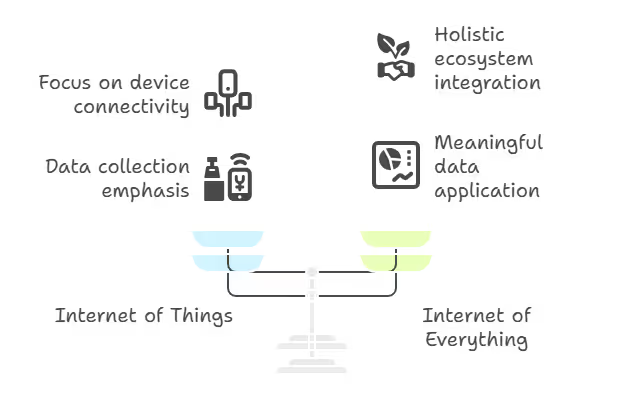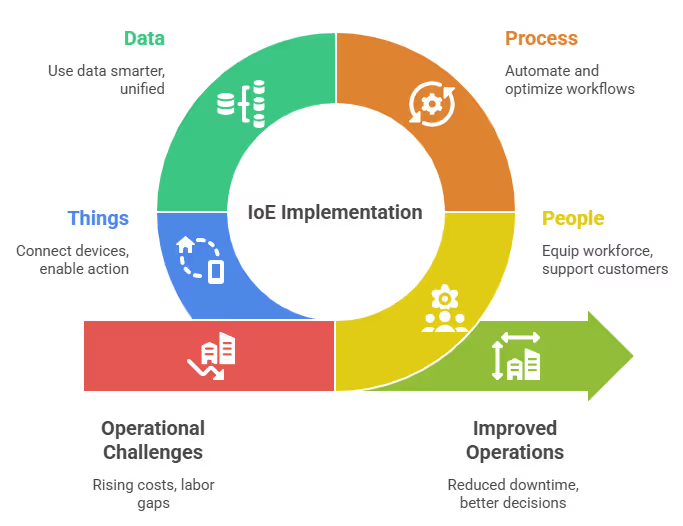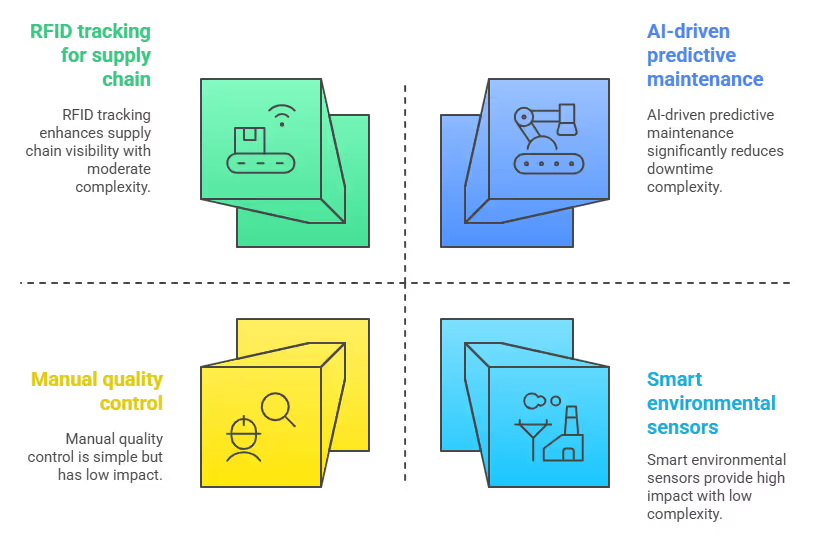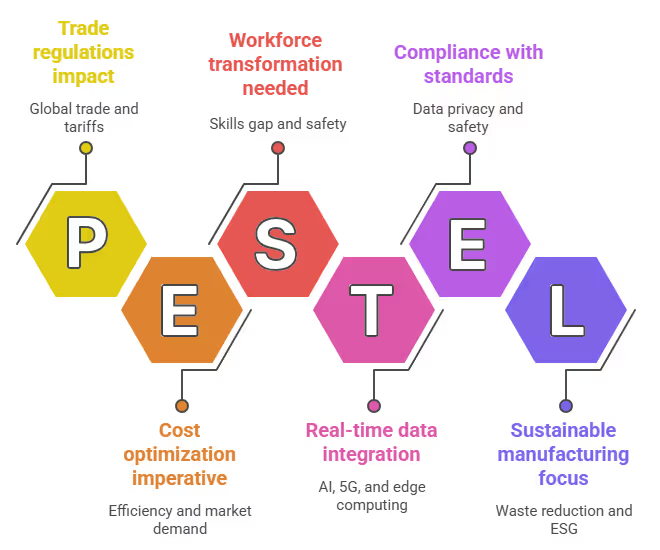What is IoE | Internet of Everything Explained for Businesses

When people ask, “What is IoE?”, they’re usually exploring how technology is evolving beyond the Internet of Things. The Internet of Everything (IoE) is the next stage of digital transformation, bringing together connected devices, big data, AI, and human interaction into a single, intelligent ecosystem. For U.S. enterprises, IoE isn’t just about connecting hardware; it’s about enabling smarter decision-making, predictive operations, and new business models that drive growth in today’s competitive economy.
What is IoE?
The Internet of Everything (IoE) is the intelligent connection of people, processes, data, and things to create smarter networks and deliver actionable insights. Unlike IoT, which mainly connects devices, IoE integrates human input, advanced analytics, and automated decision-making to transform how businesses operate, optimize efficiency, and improve customer experiences.
As a digital product strategy and consulting team with over 15 years of hands-on experience in U.S. manufacturing environments, we’ve seen this transformation up close. We've helped clients across industries, from aerospace to electronics, turn disconnected machines and systems into fully integrated operations with measurable impact.
This article breaks down the Internet of Everything in manufacturing into four core pillars and shows exactly how these systems work on the factory floor. You'll also get practical insights on key challenges like cybersecurity, integration, and scaling across multiple sites.
If you're planning your next step toward a smarter factory, this guide gives you a clear, usable framework to get there.
The Internet of Everything (IoE) connects people, processes, data, and things to create intelligent, responsive systems that drive efficiency and innovation in manufacturing.
The internet of everything in manufacturing is changing how manufacturing factories work to increase productivity and revenue.
Table of Contents
- IoE and IoT: What's the Real Difference?
- The Four Key Parts of IoE
- How IoE in Manufacturing Solves Your Factory's Biggest Problems
- Addressing the Challenges of IoE in India
- The Technology That Powers IoE: 5G and Edge Computing
- Internet of Everything in Manufacturing - Future Trends
- People Also Ask
The Difference Between IoE and IoT: A Critical Distinction for Manufacturers
It’s a common point of confusion: IoE vs. IoT. While often used interchangeably, there is a fundamental difference between IoE and IoT that is critical for any manufacturer to understand. Getting this wrong can lead to a narrow, siloed digital strategy that misses the bigger picture.
Simply put, the Internet of Things (IoT) is a subset of the Internet of Everything.
- Internet of Things (IoT): The IoT focuses on the connection of physical "things", devices, sensors, and actuators. It's about machine-to-machine (M2M) communication. Think of a sensor on an assembly line that measures vibration and sends an alert if it exceeds a certain threshold. The focus is on the object and its data.
- Internet of Everything (IoE): The IoE is a holistic philosophy, originally coined by Cisco, that expands on IoT. It’s not just about the "things," but about how you connect people, processes, and data with those things to create a more comprehensive and valuable system. It’s about creating an entire ecosystem that delivers meaningful business outcomes, not just collecting data.
In the context of the manufacturing sector, an IoT solution might tell you that a machine is about to fail. An internet of everything system, however, would connect that sensor data to a maintenance process, automatically alert the nearest available technician (people), check the inventory for replacement parts (data), and initiate a work order, all while a central dashboard (part of our custom Web App Development service) gives a real-time overview. This is the core distinction: IoE is about the ecosystem of value, not just the connected devices.
The Four Pillars of the Internet of Everything (IoE)
Built for U.S. Manufacturers Facing Real Operational Challenges
A good IoE (Internet of Everything) strategy isn’t just about “going digital” or adding more devices. It’s about connecting what you already have, people, machines, data, and workflows, in a way that drives decisions, reduces downtime, and supports actual operations.
For U.S. manufacturers dealing with rising costs, labor gaps, and supply chain risks, these four IoE pillars are not optional, they’re foundational.

1. People: Equip Your Workforce and Support Your Customers
IoE begins with people, not machines. Data only works when your team can access it and act on it. This includes operators, technicians, line managers, and customers.
Practical U.S. use cases:
- Connected Workers: Use tablets, wearables, or smart glasses to give workers real-time access to job instructions, safety alerts, and inspection tasks.
→ Example: A line operator in Ohio receives a vibration alert and preventive action checklist directly on a wrist device. - Customer Transparency: Allow customers to track their orders across U.S. plants and warehouses. This builds trust, especially for OEMs who require compliance and traceability.
- Remote Expertise: Support field teams or smaller facilities with AR tools that let central engineers offer real-time support—reducing travel time and response delays.
Why it matters: U.S. factories need to do more with fewer people. A connected workforce helps maintain output, reduce errors, and improve communication across shifts and sites.
2. Process: Automate and Optimize What Already Exists
Connecting machines is only useful if your processes can keep up. IoE helps turn live machine data into workflows that trigger the right actions, in real time.
What this looks like in practice:
- Automated Workflows: When a CNC machine shows abnormal vibration, your system should log the issue, send it to the maintenance queue, and assign a technician without human intervention.
- Predictive Maintenance: Instead of checking every motor monthly, monitor health metrics and act only when anomalies appear. This cuts unnecessary labor and reduces downtime.
- Smart Scheduling: Sync demand forecasts, inventory levels, and live machine capacity so production plans can shift as needed. Useful for multi-site U.S. operations trying to balance regional demand.
Why it matters: Manual scheduling and time-based maintenance don’t scale. Automation and real-time logic allow factories to respond faster with less overhead.
3. Data: Use What You Already Collect—Smarter
Most U.S. factories are already generating huge volumes of data, from PLCs, MES, ERP, sensors, and more.
The challenge is using it in ways that are clear and useful.
Key capabilities:
- Unified Data Platforms: Bring together operational data from the shop floor (SCADA, sensors) and business systems (ERP, CRM) into a single system of record.
- Real-Time Insights: Use AI to spot trends like rising defect rates or slowing machine cycles, without needing a data scientist on staff.
- Natural Language Access: Instead of digging through dashboards, let supervisors ask a chatbot, “Which machines had the highest unplanned downtime this week?” and get an answer in seconds.
Why it matters: If your data is trapped in silos, you’re flying blind. Real-time insights help U.S. plants react before problems spread, whether it’s a machine failure or a missed delivery.
4. Things: Sensors, Devices, and Machines That Talk and Listen
This pillar is the foundation of the physical layer. It's not just about connecting devices, it’s about making them work together and act with purpose.
Common smart devices in U.S. factories:
- Sensors: Capture temperature, vibration, humidity, pressure, power consumption, or cycle times on machines and conveyors.
- Robots and Cobots: Automate repetitive, hazardous, or high-precision tasks, especially useful in plants with labor shortages.
- RFID + GPS: Track WIP (work in progress), tools, parts, or containers across large facilities or between U.S. plants.
- Edge Devices: Run analytics at the device level (on-site) so machines can act immediately, like shutting down when a threshold is breached, without waiting on the cloud.
Why it matters: You can’t improve what you can’t measure. And in the U.S. market, where energy, quality, and efficiency are critical, smart devices provide the data needed to compete.
Why Pillars of IOE Work Only When Combined
Too many companies focus only on sensors or dashboards. But IoE works only when all four pillars support each other:
- Without Things, there’s no data.
- Without Data, there’s no insight.
- Without Process, there’s no action.
- Without People, nothing changes.
They form a closed feedback loop that drives action from insight, not guesswork.
Example: A sensor picks up a pressure drop → AI analyzes the cause → A technician gets alerted → Maintenance is scheduled → Production keeps moving → Downtime avoided.
Solving U.S. Manufacturing Challenges with the Internet of Everything (IoE)
Practical Solutions That Deliver Measurable Results
The internet of everything in manufacturing is more than a trend, it’s a practical framework to solve real-world problems in factories across the United States. From excessive downtime to safety concerns, manufacturers face increasing pressure to do more with less. IoE brings together machines, data, workflows, and people to close these gaps, streamline operations, and deliver business value.
Here's how it directly addresses the most common pain points we’ve seen across U.S. manufacturing facilities.

Unplanned Downtime and High Maintenance Costs
Unpredictable equipment failures remain one of the biggest drains on productivity. Many plants still depend on routine maintenance schedules that don’t reflect how equipment is actually performing.
With IoE, manufacturers can:
- Install smart sensors that monitor vibration, temperature, and machine load in real time
- Use AI models to predict when a component is likely to fail
- Automatically trigger maintenance work orders before failure occurs
- Align service schedules with planned downtimes to avoid production disruption
Results we've delivered: 20–40% reduction in unplanned downtime, and significantly lower repair costs.
Limited Supply Chain Visibility
Lack of real-time insight across the supply chain creates delays, stockouts, and poor inventory decisions. Materials go missing. Deliveries are late. And teams have no clear visibility into what’s happening between suppliers and the shop floor.
IoE solves this by enabling:
- RFID tracking for inventory, parts, and raw materials across multiple sites
- GPS-enabled sensors that monitor shipments in real time, including location, temperature, and condition
- Unified dashboards that give teams full visibility from supplier to customer
- Early alerts when delays or damage are detected, so teams can respond quickly
Impact: Up to 30% improvement in delivery performance and better coordination across procurement, logistics, and production.
Manual and Inconsistent Quality Control
In many U.S. factories, quality checks still rely heavily on manual inspection. This not only slows down the process but also leads to inconsistencies, missed defects, and customer complaints.
IoE quality solutions include:
- High-resolution cameras installed along production lines to capture product images in real time
- AI-powered computer vision systems that detect defects faster and more accurately than manual inspection
- Automatic rejection of defective items, reducing the risk of faulty products reaching customers
- Real-time analytics that identify the root cause of recurring issues, allowing for quick process adjustments
Outcome: Defect rates reduced by 30–50%, and compliance with international quality standards like ISO 9001 strengthened.
Worker Safety and Environmental Risk Monitoring
Ensuring safety in large or complex industrial environments is difficult without live data. Manual monitoring often misses early warning signs that could prevent accidents or environmental violations.
IoE safety solutions are designed to:
- Deploy smart environmental sensors that monitor air quality, gas leaks, noise levels, and temperature changes
- Provide workers with wearables that track proximity to hazards and trigger alerts when safety limits are crossed
- Log safety data automatically to support OSHA compliance and internal audits
- Create digital incident reports in real time, improving response time and accountability
Results: Safety incidents reduced by up to 40%, and improved visibility for EHS (Environment, Health & Safety) teams.
Why This Matters
Each of these solutions is a building block in a larger, integrated system. The internet of everything in manufacturing doesn’t just solve individual problems, it creates a connected environment where every action is informed by real-time data. Machines know when to stop. People know when to act. Systems know how to respond.
And that's what makes it work.
The Technology That Powers IoE: 5G and Edge Computing
For an IoE system to work perfectly, it needs the right technical foundation.
Two key technologies make this possible: 5G and Edge Computing.
- Edge Computing processes data right on the factory floor, near the "things" that are collecting it. Why is this important? Because it means that information doesn't have to travel to a faraway data center and back. This results in incredibly low latency, which is the time it takes for a system to react. For a robot that needs to stop instantly or a camera that needs to spot a defect in real-time, this is non-negotiable.
- 5G Networks provide the super-fast, reliable wireless connections needed to handle the massive amounts of data flowing from thousands of sensors and devices. Think of it as the superhighway for your factory's data. It allows Edge Computing and all the other parts of IoE to work together without any delays.
Together, these two technologies create a responsive, powerful platform for the smart factory.
Future Trends Shaping the Internet of Everything in Manufacturing
The internet of everything in manufacturing is not a static concept. It’s evolving fast, driven by technological innovation, market pressure, and the need for real-time decision-making. While many factories have made early strides with IoT and automation, the next generation of smart factories will go far beyond that. They’ll use live data, intelligent systems, and flexible architectures to create environments that can adjust instantly, scale efficiently, and run with minimal intervention.
Here are the major trends already reshaping how U.S. factories operate, and what you should be watching next.

1. Digital Twins Will Move from Concept to Core Infrastructure
The digital twin is no longer experimental, it’s becoming essential. A digital twin is a real-time virtual model of your physical asset: a machine, a line, or even your entire plant. Unlike static dashboards or 3D renderings, a true digital twin is dynamic, it changes as the physical system changes.
In action:
Factories use digital twins to simulate production schedules, run stress tests on equipment, and even predict the effects of a line change before committing to it physically. For instance, before modifying a robot’s movement or replacing a legacy press, engineers can test it in the twin to avoid costly downtime.
Why it matters:
Digital twins enable safer upgrades, faster iterations, and better risk management. In high-stakes industries like aerospace, electronics, and defense, this saves time, money, and reputation.
2. AI, Robotics, and IoE Will Merge into One Unified System
Today, many manufacturers treat IoE, AI, and robotics as separate investments. But the real power comes when they work as a single intelligent network. Think of IoE as the nervous system, AI as the brain, and robotics as the hands of your operation.
In action:
Imagine a packaging robot receiving live data about product defects, adjusting grip pressure based on product type, and rerouting items if it detects a problem, all without human input. This is already happening in smart factories making personalized electronics or pharmaceutical kits.
Why it matters:
It creates a closed-loop system where action follows analysis in real time. This reduces downtime, improves product consistency, and makes automation more flexible, not just repeatable.
3. Edge Computing + 5G Will Make Real-Time Truly Real
With more devices, sensors, and applications running simultaneously, factories need faster processing. Edge computing solves this by processing data locally, right next to the machines, rather than sending it to the cloud. When combined with 5G, this allows for low-latency, high-bandwidth communication.
In action:
A robotic welding arm can detect a defect and correct its pattern within milliseconds, because the edge processor is located inside the controller cabinet. In a quality check station, real-time video feeds can be processed instantly to detect visual anomalies.
Why it matters:
Factories can now run ultra-responsive systems without network lag. This is critical for high-speed production, safety systems, and robotics. For U.S. manufacturers operating across large sites or with distributed teams, edge + 5G is the infrastructure backbone.
4. Hyper-Personalization Will Scale with IoE Data
Consumers are demanding personalized products, custom sizes, colors, configurations, even in traditionally rigid industries like auto or electronics. The only way to deliver that at scale is through intelligent, flexible production driven by real-time IoE data.
In action:
A factory producing smartwatches receives order specs from a customer’s app, adjusts its assembly sequence mid-batch, and ships the product with personalized packaging, all without slowing down production.
Why it matters:
Mass customization isn’t a trend, it’s an expectation. Using IoE to coordinate customer data, machine instructions, and fulfillment logistics allows manufacturers to keep up without adding costs or delays.
5. Connected Worker Platforms Will Become Standard
The shop floor workforce is transforming. New workers need faster onboarding. Experienced workers need better tools. Safety is under tighter scrutiny. Connected worker platforms meet these needs with digital tools that improve performance and awareness.
In action:
Workers wear smart helmets that deliver live instructions based on machine status. AR glasses overlay safety zones. Mobile apps alert technicians about equipment anomalies before they escalate. And team leads can view real-time performance from any location.
Why it matters:
It’s not just about productivity. It’s about giving workers the right information at the right time to reduce errors, injuries, and downtime. With labor shortages hitting U.S. manufacturing hard, this also helps close the skills gap.
6. Predictive Quality Will Replace Manual Checks
Quality control is still reactive in many factories. That’s changing. Predictive quality systems use machine vision, historical data, and IoE sensor inputs to catch issues before they become defects.
In action:
A production line combines camera-based inspection with vibration and pressure sensors to detect slight inconsistencies that lead to faults. AI algorithms flag anomalies, while the system auto-adjusts parameters to stay within quality thresholds.
Why it matters:
This reduces scrap, speeds up inspection, and keeps defect rates low, even at high volumes. It also supports compliance with international standards like ISO 9001 and IATF 16949.
7. Circular Manufacturing Will Be Data-Driven
Sustainability isn’t just a corporate talking point, it’s a customer demand. Manufacturers are being pushed to reduce waste, reuse materials, and track resource impact. IoE-enabled circular manufacturing provides the data infrastructure to do this.
In action:
Factories track the life cycle of every material, from sourcing to recycling, using RFID tags, sensor data, and blockchain-based records. Equipment usage is optimized to minimize energy waste. Water consumption is monitored and reused based on process data.
Why it matters:
It makes sustainability measurable. This helps manufacturers meet ESG goals, reduce regulatory risk, and prove transparency to clients and auditors.
8. Interoperable Ecosystems Will Define Competitive Advantage
Right now, many manufacturers run disconnected systems, MES in one silo, ERP in another, supply chain in a third. This creates delays and misalignment. IoE platforms are evolving to connect every system into a fully interoperable ecosystem.
In action:
An order from a sales platform triggers automated scheduling in MES, which updates the ERP, notifies procurement, and sends a delivery estimate to the customer—all without human input.
Why it matters:
When systems talk to each other, decisions are faster, forecasting is better, and response time shrinks. This is key to operating at the speed global markets now demand.
The internet of everything in manufacturing isn’t just about connecting machines, it’s about making every part of your operation smarter, faster, and more resilient. These trends aren’t theoretical. They’re already being rolled out across U.S. factories in sectors like automotive, aerospace, food processing, and electronics.
What separates leaders from laggards is simple: those who adapt early build more agile operations, win more contracts, and protect their margins. The time to act is now.
IoE vs. IoT: A Feature Comparison Table
What's Next
The internet of everything in manufacturing is no longer a concept of the future; it's a strategic imperative for any business looking to thrive in the digital age. By moving beyond a narrow focus on IoT and embracing the holistic IoE architecture, connecting people, processes, data, and things, manufacturers can unlock unprecedented levels of efficiency, intelligence, and competitive advantage.
From our experience as a product engineering company in India, we’ve seen how this approach helps companies reduce costs, improve quality, and create a safer, more productive environment. The key is to start with a clear strategy and a partner who understands the nuances of this complex ecosystem.
If you’re ready to explore how a tailored internet of everything strategy can transform your operations, we invite you to connect with our team. We specialize in building custom, end-to-end Product Engineering Services that are designed to solve your unique business challenges and turn your factory into a smart, interconnected powerhouse.


